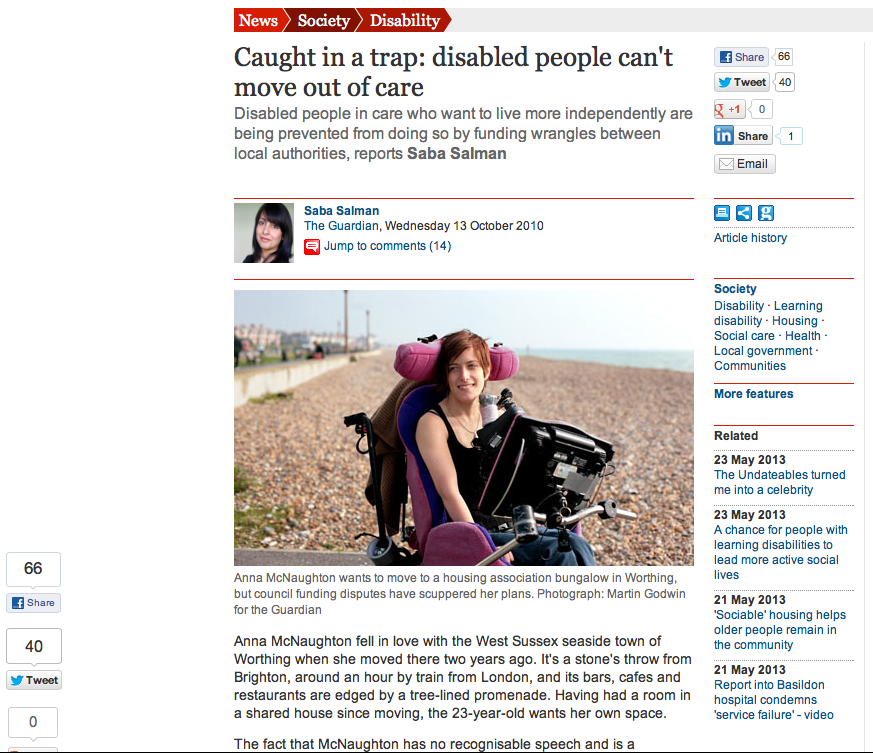
The full piece I wrote for today’s Guardian is here – please read it alongside the words of Connor’s mother, Sara Ryan, who describes the fight for justice for her son.
From today for 107 days (the length of time Connor was in Slade House), there is a campaign to raise awareness of what happened to Connor. Building on the palpable sense of anger and injustice, it is hoping to push for action.
You can follow the campaign on Twitter @JusticeforLB #JusticeforLB. Connor’s mother’s blog is here.
I’m posting some additional contributions from a few interviewees here as there wasn’t space in the published piece.
Sandie Keene, president of the Association of the Directors of Adult Social Services, stressed the fact that it’s not just social care commissioners who are responsible for the continued use of units like Slade House:
“Commissioning these days is a complex environment [it’s within] NHS England, clinical commissioning groups, social care commissioning.” Keene adds that the solution is partly “to find better ways of cascading the best practice”.
Mark Neary won a legal fight to get his autistic son, Steven, out of the kind of care Connor was in. He explained what these units are like for individuals and families: “After Steven’s experience in an assessment and treatment unit where he was unlawfully held for the whole of 2010, I question what the purpose of these places is. In our case, the judge remarked about the lack of assessment when Steven was first taken there and there didn’t appear to be any treatment taking place. The unit appeared to me to be a holding container. And a very expensive holding container at that. The other aspect of the unit that shocked me was how much families were excluded. On a major medical document, I wasn’t even mentioned as Steven’s next of kin – his keyworker at the unit was. To have my whole 20 years experience of Steven negated was quite terrifying. And worst of all, it must be awful for the person detained there to be cut off from the people who have cared for them all their life. Steven has autism. Does that need treatment? And even if it does, is it good for a person for whom routine is everything to be kept in one of these places?”
* You can read Mark’s blog and his stories of his son’s time in an assessment and treatment unit
Jenny Morris, an independent consultant who advised the previous government on disability, puts the lack of progress on moving people out of units and into the community down to two things: “There are negative attitudes in society in general toward people with learning disabilities plus ignorance or lack of understanding about how denying people the ability to communicate their needs, and failure to meet their needs, leads to “challenging behaviour. When things go wrong the response is to write new or updated standards and codes of practice etc instead of paying attention to how to recruit, retain and value people who can – because of their values – provide good care and empower people. If we paid more attention to the characteristics of people who provide good care, plus how to support them with training and good working conditions etc, and less to problematising the needs of people with learning disabilities we might not see the kind of institutional disablism that persists in so many services.”
A senior contact, who didn’t wish to be named but who runs a large care organisation, talked about the closure of long-stay hospitals and how what’s developed in their place is almost as bad: “We closed closed them and some pretty similar things have replaced them. The policy context for working with people with challenging behaviour has been clear for over 20 years..the best way to develop servives for people with challenging behaviour is individualised services around the person and it needs to be small scale local and in the community. It has been out there [ie known about and practised by the best care providers] for years, but seldom happens.”
I interviewed Katrina Percy, the chief executive of Southern Health, which ran the now-closed unit that Connor was in. Southern was criticised in an independent report into Connor’s death and is currently being investigated by health regulator Monitor.
Asking why units like Slade House exist, I mentioned the buck passing that families feels goes on between ‘stakeholders’ – with commissioners of services and clinicians complaining about the lack of community-based alternatives, and service providers for people with learning disabilities suggesting commissioners don’t know about, or cannot afford, existing alternatives. Percy replied: “I feel it’s got to be a joint piece of work, so often the experts [who sit on commissioning boards] come from our organisation, but the commissioners need to make the decision that they wish to commission this new [community-based] model of care”.
I asked if concerned the trust is worried about losing its healthcare licence given the critical reports (the report into Connor’s death and inspections by the care sector regulator, as the piece today explains). Percy responded that she did not know about a potential breach of licence, but said the trust had been in discussion with Monitor and “the organisation overall has an awful lot of strengths”. She added: “One of the hardest thing in my job is about enabling focus where things go wrong, but not allowing that to pervade a very big organisation where lots of things go very right [where] in fact we’re seen as leading edge and my job as chief exec is to absolutely make sure that we get that that balance and prioritisation and focus right.”
On the calls for her resignation, Percy replied that she would like to “meet the family and talk to them directly so they actually see what I’m like as an individual and as a chief executive.” She added: “There are many things we are very proud of in this organisation and we provides services to millions of people and therefore I think my best place is to help us continue to improve services for every single person who needs to use them.” Asked to clarify, Percy replied: “I don’t see that it’s approporiate that I would resign, no.”
Responding to what she would say if she met Connor’s family, specifically his mother Sara Ryan, Percy said: “I would apologise unreservedly that her son and her family were let down by our services…I would ask her when she feels ready, if that is what she would like to do, to continue to campaign and work with us to design a set of services where this will never happen again.”
* Seven members of staff who worked at the now-closed Slade House are subject to a “human resources investigation”, with the first disciplinary hearing due to take place this month. In an email after the Guardian piece went to press, Southern Health confirmed “three members of staff have been suspended”.



